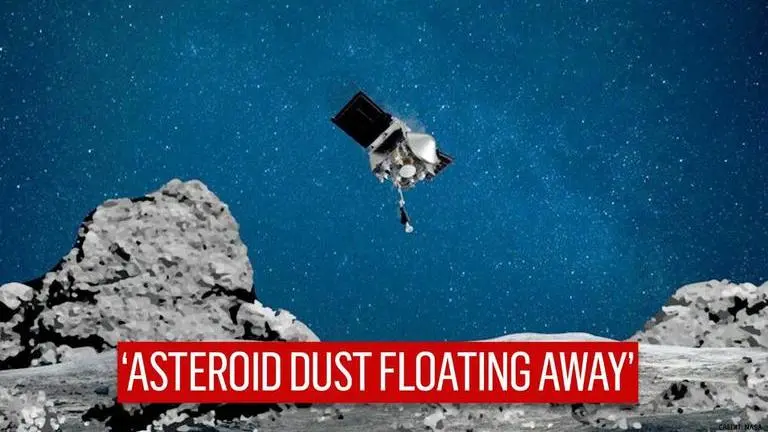Updated 24 October 2020 at 11:13 IST
NASA prepares to return Osiris-Rex to Earth after noticing dust leakage post 'TAG event'
NASA OSIRIS-REx team noticed both that the head appeared to be full of asteroid particles, and some particles escaped profusely from the sample collector flap.
- Science News
- 3 min read

On October 23, NASA informed that its spacecraft Osiris-Rex had collected a significant amount of asteroid particle samples, two days after it touched down on asteroid Bennu. However, NASA was now concerned about losing too much asteroid dust due to unforeseen leakage after the probe's sample collecting arm’s Myler flap has failed to close down completely. As a result, asteroid dust collected by Osiris-Rex is floating away in space.
In a release, NASA revealed that its Origins, Spectral Interpretation, Resource Identification, Security, Regolith Explorer (OSIRIS-REx) spacecraft accumulated an immense amount of dust and pebbles to deliver to Earth in 2023 from the well-preserved, ancient asteroid Bennu. If the sample collection event, known as Touch-And-Go (TAG), managed to collect enough dust from the asteroid, NASA’s mission team might even command the spacecraft to stow the primordial cargo and start the journey back to the earth by March 2021. According to NASA, the spacecraft’s Touch-And-Go Sample Arm Mechanism collector head gathered so much asteroid dust in the maneuver that the valve hadn’t appropriately sealed off.
[NASA’s OSIRIS-REx mission readies itself to touch the surface of asteroid Bennu. Credits: NASA/Goddard/University of Arizona]
[Captured by the spacecraft’s SamCam camera on Oct. 22, 2020, the image shows that the sampler head-on NASA’s OSIRIS-REx spacecraft is full of rocks and dust collected from the surface of the asteroid Bennu. They show also that some of these particles are slowly escaping the sampler head. Analysis by the OSIRIS-REx team suggests that bits of material are passing through small gaps where the head’s mylar flap is slightly wedged open. Credit: NASA]
Advertisement
Good news: on Oct. 20, our @OSIRISREx spacecraft captured more than enough material from asteroid Bennu to meet mission requirements! The team is now focused on stowing the sample for return to Earth in 2023: https://t.co/4etvnJzXfn #ToBennuAndBack pic.twitter.com/ILUzEJZHD8
— NASA (@NASA) October 23, 2020
Advertisement
In a live press conference, NASA’s associate administrator for science at the agency’s headquarters in Washington, Thomas Zurbuchen said that there’s so much dust in spacecraft that the diaphragm that is supposed to contain the samples is in open. Further, NASA revealed in a release that the OSIRIS-REx team noticed both that the head appeared to be full of asteroid particles, and some particles escaped profusely from the sample collector, called the Touch-And-Go Sample Acquisition Mechanism (TAGSAM) head. “They suspect bits of material are passing through small gaps where a mylar flap – the collector’s ‘lid’ – is slightly wedged open by larger rocks,” NASA scientists said. Bennu asteroid continues to surprise the scientists with throwing few curveballs, Zurbuchen said.
LIVE: Tune in for a mission update from @Dr_ThomasZ of #NASAScience & @OSIRISREx principal investigator Dante Lauretta. On Oct. 20, our spacecraft journeyed #ToBennuAndBack to collect a sample. Learn what they've found and the mission's next steps: https://t.co/mzKW5uV4hS pic.twitter.com/JvGdyDlljs
— NASA (@NASA) October 23, 2020
Empty collector head images compared
A team at NASA compared the empty collector head with Oct. 22 images when the dust was accumulated in TAGSAM head. Scientists now worry that the spacecraft and the TAGSAM instrument movement might result in further dust loss. NASA, for now, has foregone the Sample Mass Measurement activity and braking burn for Osiris-Rex scheduled for Saturday, Oct. 24 in order to reduce accelerating the spacecraft and losing sample. The team is now focusing on stowing the Sample Return Capsule (SRC).
“We are working to keep up with our own success here, and my job is to safely return as large a sample of Bennu as possible,” said Dante Lauretta, OSIRIS-REx principal investigator at the University of Arizona in Tucson. “The loss of mass is of concern to me, so I’m strongly encouraging the team to stow this precious sample as quickly as possible,’ he added.
[OSIRIS-REx mission’s sample collection event, this series of images shows the SamCam imager’s field of view as the NASA spacecraft approaches asteroid Bennu’s surface. Credit: NASA]
Published By : Zaini Majeed
Published On: 24 October 2020 at 11:14 IST



